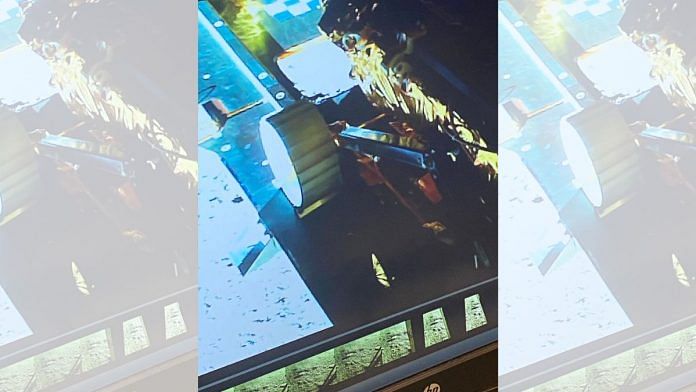New Delhi: Another payload aboard Chandrayaan-3’s rover Pragyan has re-confirmed the presence of sulphur on the lunar south pole, a feat India’s space agency said would force scientists to rethink the element’s source – was it “intrinsic, volcanic or meteoritic?”
The Indian Space Research Organisation (ISRO) posted on X Thursday that the presence of sulphur was established through another technique – two days after Pragyan’s Laser-Induced Breakdown Spectroscope unambiguously found the element on the Moon.
This time around, the Alpha Particle X-ray Spectroscope (APXS) detected sulphur as well as “other minor elements”, ISRO said.
“This finding by Ch-3 compels scientists to develop fresh explanations for the source of Sulphur (S) in the area: intrinsic?, volcanic?, meteoritic?” the space agency said.
The accompanying video in the post shows the “automated hinge mechanism rotating the 18 cm tall APXS, aligning the detector head to be approximately 5 cm in proximity to the lunar surface”, ISRO explained.
Chandrayaan-3 Mission:
In-situ Scientific Experiments
Another instrument onboard the Rover confirms the presence of Sulphur (S) in the region, through another technique.
The Alpha Particle X-ray Spectroscope (APXS) has detected S, as well as other minor elements.
This… pic.twitter.com/lkZtz7IVSY
— ISRO (@isro) August 31, 2023
The detection of sulphur with such in-situ measurements was not feasible by instruments onboard the orbiters, ISRO has said previously.
Meanwhile, the rover was once again rotated in search of a safe route on the surface on Wednesday, ISRO said, posting more photos of Pragyan as captured by lander Vikram.
Chandrayaan-3 Mission:
The rover was rotated in search of a safe route. The rotation was captured by a Lander Imager Camera.
It feels as though a child is playfully frolicking in the yards of Chandamama, while the mother watches affectionately.
Isn't it?🙂 pic.twitter.com/w5FwFZzDMp
— ISRO (@isro) August 31, 2023
After its historic landing on the Moon’s south pole on 23 August – making India the first country to touch down in that region – the lander and rover modules are carrying out on-surface experiments and will last one Moon day or 14 Earth days. This is because both are solar powered.
Pragyan has two payloads: Alpha Particle X-ray Spectrometer (APXS) and Laser Induced Breakdown Spectroscope (LIBS), which will analyse and map the elemental composition of the regolith (lunar soil) and negligible atmosphere in the neighbourhood of the landing site.
While Vikram carries four — the Radio Anatomy of Moon Bound Hypersensitive Ionosphere and Atmosphere (RAMBHA) will study the local gases and plasma in the environment and their variations; the Chandra’s Surface Thermophysical Experiment (ChaSTE) will study the Moon’s thermal conductivity and surface temperature, the Instrument for Lunar Seismic Activity (ILSA) is for measuring the seismicity around the landing site, and a passive Laser Retroreflector Array (LRA) from NASA will allow for lunar laser ranging studies.
Also read: Chandrayaan-3 landing done. It’s now over to Pragyan Rover for next phase of Moon mission



